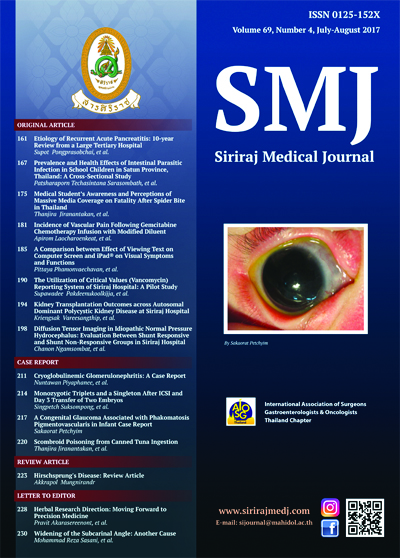The Utilization of Critical Values (Vancomycin) Reporting System of Siriraj Hospital: A Pilot Study
Abstract
Objective: The critical values of the drug level are defined as the drug concentrations which are greater or lower than therapeutic values. These greater values can cause drug toxicity while the lower values lead to inadequate treatment, and both require immediate attention from physician. Critical values are reported to physician by telephone, but the utilization of critical values and physician’s intervention has not been recognized. The present study was to determine the utilization rate of the critical values (vancomycin) reporting system and to identify the incidence of false positive result of critical values of vancomycin blood level.
Methods: The nurses who worked in 8 medicine wards, Siriraj Hospital were interviewed by telephone questionnaires including two main questions for 3 months.
Results: The results showed that the utilization rate of the critical values reporting system was 88.81%. After critical values were reported, the physician adjusted dosage of vancomycin 60.63%, drug discontinuation 23.62% and adjusted nothing 15.75%. The incidences of false positive result of critical values (vancomycin) were 1.38%.
Conclusion: The critical values reporting system remains important to help physicians in dose adjustment in critically ill patients or problematic patients such as abnormal drug clearance (liver and kidney diseases) or drug interactions. However, the therapeutic drug monitoring should be used carefully and correlated with clinical signs and symptoms due to the presentation of false positive of the critical values of vancomycin blood level.
Downloads
Published
How to Cite
Issue
Section
License
Authors who publish with this journal agree to the following conditions:
Copyright Transfer
In submitting a manuscript, the authors acknowledge that the work will become the copyrighted property of Siriraj Medical Journal upon publication.
License
Articles are licensed under a Creative Commons Attribution-NonCommercial-NoDerivatives 4.0 International License (CC BY-NC-ND 4.0). This license allows for the sharing of the work for non-commercial purposes with proper attribution to the authors and the journal. However, it does not permit modifications or the creation of derivative works.
Sharing and Access
Authors are encouraged to share their article on their personal or institutional websites and through other non-commercial platforms. Doing so can increase readership and citations.











